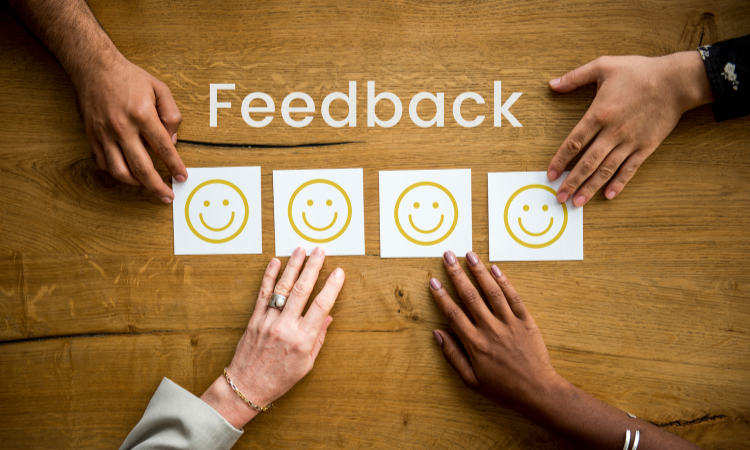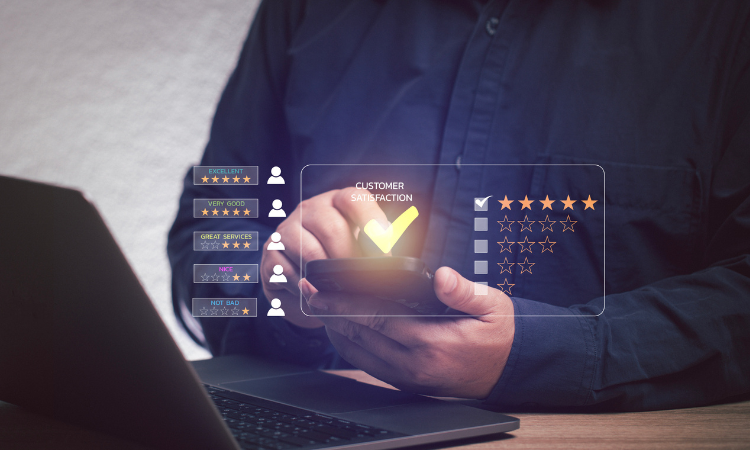Imagine having a crystal ball that could predict your customers' loyalty and highlight areas needing improvement. This is what Net Promoter Score (NPS) feedback offers to businesses. In today's competitive market, understanding and leveraging customer feedback is no longer optional—it's a necessity.
For enterprise-scale organizations, the stakes are even higher. According to a Bain & Company study, companies that excel at customer experience grow revenues 4-8% above their market. Yet, despite the clear benefits, many businesses struggle to effectively collect and act on NPS feedback.
Consider Netflix, which uses NPS feedback to enhance its user experience. By collecting feedback after major content releases, Netflix pinpoints what their audience loves and what needs improvement. This proactive approach helps them stay ahead of competitors and continuously refine their service, contributing to high customer retention rates and market success.
In this article, we'll explore the critical aspects of collecting NPS feedback: how to design and distribute surveys, when to ask for feedback, and where to place your surveys for maximum impact. By the end, you'll have a comprehensive understanding of how you can enhance your NPS program to drive customer loyalty and business success. Let’s get started!
TL;DR
- NPS provides insights into customer loyalty, highlights areas for improvement, and helps turn detractors into promoters and promoters into brand advocates.
- By designing engaging NPS surveys, segmenting your audience, automating survey distribution, using an omnichannel approach, and closing the feedback loop, you can collect NPS.
- NPS must be collected after significant customer interactions such as purchases, support calls, onboarding, or at regular intervals like quarterly or annually.
- NPS should be collected at key touchpoints including post-purchase, during onboarding, after renewals, following marketing campaigns, and through various channels like email, SMS, in-app, and web widgets.
- Zonka Feedback is a powerful NPS software that helps you engage with customers, measure their loyalty, and identify ways to prevent churn through its NPS surveys. You can sign up for a 14-day free trial or schedule a demo to see how it turns out for your business!
Measure Customer Loyalty with NPS ❤️
Create NPS surveys, measure customer loyalty, and close the feedback loop with Zonka Feedback.

How to Collect NPS Feedback?
Let us begin by first looking at how to gather NPS survey feedback. Collecting NPS surveys effectively requires a strategic approach to ensure you capture accurate and actionable feedback.
Here are some key strategies that can guide you towards enhancing your NPS collection process:
a. Design the NPS Survey
The success of your NPS surveys hinge on the questions you ask. A well-designed survey provides valuable insights beyond the core NPS survey question.
Consider this: Asking an open-ended question like "Why did you choose that score?" can offer rich qualitative data to complement the quantitative NPS metric.
Apple is renowned for its attention to detail. Their NPS surveys often include follow-up questions that delve into specific product features or customer experiences. This helps them identify areas for improvement and innovation.
Pro Tip: Explore advanced question types like matrix questions, Likert scales, and semantic differential scales to gather nuanced NPS feedback.
Here’s how you can make the most from your NPS survey to collect maximum feedback:
- Keep it Short and Sweet: Aim for a survey that can be completed in under two minutes. Prioritize the most critical questions and provide clear instructions. Consider using progressive disclosure or survey logic and branching, where additional questions are presented based on previous answers.
- Leverage Visuals: Use a simple smiley face survey instead of just numbers to represent the NPS rating to make it more engaging and accessible. Explore the use of interactive elements like sliders or drag-and-drop features to enhance the survey experience.
- Ensure Mobile Optimization: With the increasing use of smartphones, it's crucial to ensure your survey is mobile-friendly. The design should be responsive and easy to navigate on smaller screens.

b. Segmentation: Know Your Customers to Know Your Questions
The golden rule of effective NPS surveys is personalization. Treating all customers alike is like sending a mass email with the same subject line to everyone - it's inefficient and often ineffective. NPS segmentation allows you to tailor your questions to specific customer groups, yielding more actionable insights.
Imagine this: A luxury car manufacturer sends the same NPS survey to both first-time buyers and long-term owners. While both groups are valuable, their experiences, expectations, and pain points differ significantly. A new owner might be asked about their buying experience, while a long-term owner might be queried about the car's performance and after-sales service.
Amazon, the e-commerce giant, is a master of segmentation. They send different surveys to Prime members, casual shoppers, and business customers. This granular approach helps them understand the unique needs of each segment and tailor their offerings accordingly.
Here’s how you can make your NPS segmentation even more effective:
- Use Advanced Segmentation: Consider employing advanced customer segmentation models based on demographics, behavior, purchase history, and lifetime value to uncover hidden patterns and insights.
- Create Customer Personas: Develop detailed profiles of your ideal customer segments to better understand their needs and preferences.
- Prioritize Segments: Focus on high-value segments for more in-depth analysis and targeted interventions.
- Dynamic Segmentation: Use real-time data to adjust segments and survey questions as customer behavior evolves.

c. Send Surveys at Optimal Times with Automation
Timing is everything when it comes to NPS surveys. Sending them at the right moment can significantly impact response rates and the quality of feedback. Automation can come in handy to do that.
Let's say you run a SaaS company. Sending an NPS survey immediately after a customer successfully completes a critical onboarding step is strategic. It allows you to capture their initial impressions and identify any pain points early on.
Automation tools can be set up to trigger surveys based on specific actions, such as making a purchase, completing a support ticket, or renewing a subscription. This ensures that feedback is collected when it matters most.
Here’s how you can use automation to collect NPS:
- Integrate NPS automation with CRM: Consider integrating NPS automation with your CRM and marketing automation platforms. This enables you to leverage existing customer data for more precise targeting and segmentation.
- Utilize Customer Lifecycle Triggers: Automate surveys based on customer lifecycle stages (e.g., trial end, first purchase, renewal, contract expiration).
- Implement Event Based Triggers: Send surveys after specific events or milestones (e.g., product launch, feature release, customer support interaction).
- Create Custom Automation Workflows: Build complex automation rules based on multiple criteria (e.g., customer segment, purchase value, support interactions).
d. Omni-Channel Approach: Meet Your Customers Where They Are
In today's digital age, customers interact with brands across multiple channels. A truly effective NPS program must mirror this behavior.
Think about it: Some customers prefer email, while others are more responsive to SMS. Some might be happy to fill out a survey within your mobile app, while others might prefer a traditional paper-based questionnaire.
To maximize your reach, consider using a combination of email, SMS, in-app surveys, and even offline methods like kiosks or phone calls. This ensures that you capture feedback from a diverse customer base. We will discuss the survey channels in more detail in our ‘where’ section.
Pro Tip: Develop a comprehensive omni-channel strategy that considers customer preferences, demographics, and the nature of the interaction. For instance, a younger demographic might respond better to SMS or in-app surveys, while older customers might prefer email or phone.
e. Closing the Feedback Loop for Enhanced Satisfaction
Collecting NPS data is just the first step. What truly matters is how you respond to that feedback. A closed feedback loop demonstrates your commitment to customer satisfaction.
Imagine a customer who rates your product a 6 out of 10. They leave a comment mentioning a specific issue they encountered. A company that truly cares would acknowledge their feedback, apologize for the inconvenience, and outline the steps being taken to address the problem.
Since this step is extremely crucial in NPS feedback collection, you can leverage NPS tools like Zonka Feedback that helps you streamline this process by automating follow-ups and assigning tasks to relevant teams.
When to Gather NPS Survey Feedback?
Timing is crucial when it comes to collecting NPS data. Sending surveys at the right moment can significantly impact response rates and the quality of feedback you receive. Let's break down the optimal timing for different types of surveys and industries.
Pro Tip: An NPS survey must be sent after the customer has thoroughly experienced your products or service. This is because it measures customers' loyalty and willingness to speak positively about your brand, which can only happen once they have had the chance to interact with your brand.
When is the Right Time to Send Transactional NPS Surveys?
Transactional NPS surveys focus on a specific interaction or transaction, such as a purchase or customer service interaction. They capture immediate feedback, allowing you to identify issues and address them promptly.
Ideal times to send transactional NPS surveys include:
- Immediately After a Purchase: This helps gauge customer satisfaction with the buying experience and product. For example, Amazon sends post-purchase surveys to understand customer satisfaction with their delivery service.
- After a Customer Service Interaction: This provides valuable insights into the quality of your support. For instance, a telecommunications company might send a survey after a customer service call to assess the agent's performance.
- Following a Product or Service Delivery: This helps measure customer satisfaction with the product or service itself. For example, a furniture retailer might send a survey after a customer receives their order to gauge satisfaction with the delivery process.
- After App or Software Downloads: Capturing feedback early helps identify any onboarding issues and improve the user experience.
- After Training or Workshop Completion: Assessing participant satisfaction helps refine future training programs.
- After Event Attendance: Gathering feedback immediately after an event helps measure attendee satisfaction and identify areas for improvement.

When is the Right Time to Send Relational NPS Surveys?
Relational NPS surveys help you track customer loyalty and satisfaction over time. It's essential to strike a balance between collecting enough data and overwhelming customers. Consider sending relational surveys:
- Subscription Renewals: Measuring customer satisfaction at renewal points provides insights into retention and churn prevention.
- Regular Purchase Intervals: For customers making repeat purchases, sending surveys at regular intervals helps gauge overall satisfaction and loyalty.
- Annual Customer Reviews: Conducting annual surveys provides a comprehensive overview of customer sentiment and identifies long-term trends.
- Post-Campaign Evaluations: Measuring the effectiveness of marketing campaigns helps optimize future efforts.
- Quarterly or Annually: This provides a snapshot of overall customer sentiment and helps identify trends over time. For example, many SaaS companies send annual NPS surveys to gauge customer satisfaction and loyalty.
- After Significant Milestones: For example, after a customer reaches a certain usage level or tenure, or after a major product update.

Right Time to Send NPS Survey for Different Industries
The optimal timing for NPS surveys can vary significantly depending on the industry. Tailoring the timing of your surveys to your specific industry can help ensure you capture the most relevant and actionable feedback. Let's look at the optimal timing for major industries:
1. NPS Survey Timing for Retail and e-Commerce
Retail and e-commerce businesses often have shorter customer lifecycles, making transactional NPS surveys particularly valuable. You can send NPS surveys in these times:
- Immediately after Post-Purchase: Capturing first impressions is essential. For example, Amazon's rapid-fire surveys after purchases help them understand customer satisfaction in real-time.
- Post-Delivery: Assessing the delivery experience is crucial. Companies like Warby Parker have benefited from understanding how the delivery process impacts customer satisfaction.
- Post-Return or Exchange: Capturing feedback after returns or exchanges helps identify issues with products or services. This can improve customer satisfaction and reduce return rates.
- Seasonal Surveys: For industries with seasonal fluctuations (e.g., apparel, holiday decor), sending surveys after peak seasons can provide valuable insights into customer satisfaction.
2. NPS Survey Timing for B2B and SaaS brands
B2B and SaaS businesses often have longer sales cycles and customer relationships, requiring a different approach to NPS timing. Use NPS surveys in these times:
- Post-Implementation: Understanding customer satisfaction after product implementation is critical. Salesforce, for instance, uses NPS to measure customer success post-implementation.
- Quarterly or Annual Check-ins: Tracking customer satisfaction over time helps identify areas for improvement and uncover potential churn risks.
- Post-Customer Support Interactions: Measuring customer satisfaction with support services can improve overall experience.
- Post-Product Updates or Feature Releases: Assessing the impact of new features on customer satisfaction can inform future product development.
- Account Expansion or Upsell Opportunities: Understanding customer satisfaction can identify opportunities for growth.
3. NPS Survey Timing for On-Demand Products
On-demand businesses operate in a fast-paced environment, requiring timely feedback to address issues promptly.
- Immediately Post-Service: Capturing feedback while the experience is fresh in the customer's mind is essential. Uber, for example, sends surveys immediately after rides to understand customer satisfaction.
- Peak Usage Periods: Understanding customer satisfaction during high-demand periods can help optimize resource allocation.
- Post-Service Issues: Sending surveys after addressing service issues helps measure customer satisfaction with the resolution.
4. NPS Survey Timing in Healthcare
The healthcare industry has unique considerations for NPS timing due to the sensitive nature of the relationship between patients and providers. The NPS in healthcare can be used for:
- Post-Appointment: Capturing feedback immediately after appointments helps address patient concerns and improve care delivery.
- Post-Discharge: Assessing overall patient satisfaction with hospital stays is crucial for improving patient experiences.
- Follow-up Surveys for Chronic Conditions: Tracking patient satisfaction over time can identify areas for improvement in chronic care management.
- Post-Treatment Surveys: For elective procedures or complex treatments, sending surveys after treatment completion helps measure patient satisfaction.
5. NPS Survey Timing for Service Transactions
Service-based businesses rely on customer satisfaction to drive repeat business. If you are in this industry, the optimal timing for your NPS surveys would include:
- Immediately Post-Service: Capturing feedback while the service is fresh in the customer's mind is essential. For example, a cleaning service might send a survey immediately after a clean.
- Periodic Checks for Repeat Customers: Tracking customer satisfaction over time helps identify opportunities for improvement and loyalty programs.
- Post-Service Complaint Resolution: Measuring customer satisfaction after resolving a complaint helps assess the effectiveness of complaint-handling processes.
Where to Collect NPS Survey Feedback?
Collecting NPS feedback at the right touchpoints and from the right survey channel is crucial for gaining valuable insights into the customer experience. By strategically placing survey collection points throughout the customer journey and using different survey channels, you can better understand customer sentiment and identify areas for improvement.
Let us first look at the key customer touchpoints where you can collect NPS survey feedback.
Key Touchpoints for Collecting NPS Feedback
Here are some of the key touchpoints where you must collect NPS feedback to get a comprehensive understanding of customer sentiment and drive loyalty.
a. Post-Purchase or Post-Service Interaction
Gathering feedback immediately after a purchase or service interaction helps you to capture the customer’s initial reaction to the product or service.
You can send an NPS survey via email or SMS right after the transaction is completed.
For instance, if you run a luxury hotel chain, you can implement post-stay NPS surveys sent via SMS immediately after check-out. This timing will allow you to capture guests' fresh impressions of their stay, leading to actionable insights that can help improve guest satisfaction and increase repeat bookings.
b. Onboarding Process
Understanding the customer’s experience during onboarding can highlight areas for improvement in initial interactions, which are critical for setting the tone of the customer relationship.
For this, you can deploy in-app surveys or emails after the onboarding steps are completed. Slack, for instance, sends an in-app survey to new users after they complete the onboarding process to gauge their satisfaction with the setup and initial use.
c. Product or Service Renewal
Renewal periods are opportune moments to gauge ongoing satisfaction and address any concerns that might affect renewal decisions. For this, you can trigger email or SMS surveys a few days before and after the renewal date.
For instance, Salesforce sends NPS surveys to customers before their subscription renewal date to understand their current satisfaction and address any potential issues.
d. Marketing Campaigns and Promotions
Capturing feedback during or after marketing campaigns and promotions helps measure the effectiveness of these initiatives and their impact on customer satisfaction. You can send NPS surveys via email or SMS after a campaign ends or a promotion is redeemed.
If you run a retail company, you can send NPS surveys after major sales events like Black Friday to understand customer satisfaction with the promotions.
e. Sales and Account Management Interactions
Sales and account management interactions are crucial for building and maintaining customer relationships. Measuring NPS after these interactions helps assess satisfaction and identify improvement areas. For this, you can deploy email or in-app surveys after significant sales meetings or account reviews.
For instance, a B2B software company can send NPS surveys after quarterly business reviews with key accounts to gauge satisfaction with account management.
f. Billing and Payment Experience
The billing and payment experience can significantly impact customer satisfaction. Measuring NPS after billing interactions helps identify issues and improve the overall experience. You can send email surveys shortly after billing cycles or payment transactions.
For example, if you run a subscription-based service, you can implement NPS surveys to your customers after each billing cycle. You might find that there is a confusion around billing details. To address this issue, you can establish clearer communication and support for an improved overall customer satisfaction and reduced churn.
g. Key Milestones
Important milestones such as anniversaries, significant usage milestones, or contract completions provide an opportunity to check in on customer satisfaction. You can schedule automated NPS surveys through CRM integrations to send at these key times.
For instance, Dropbox sends an NPS survey on the one-year anniversary of a customer’s subscription to gauge long-term satisfaction and gather feedback on their overall experience.
Effective Channels for NPS Feedback Collection
Let us look at different survey channels along with their use case and advantages so that you do not miss out on any channel and maintain an effective NPS feedback process.
1. Email Surveys
Email remains a powerful tool for NPS feedback collection due to its high reach, personalization capabilities, and ease of tracking. It's particularly effective for post-purchase feedback, renewal reminders, customer satisfaction assessments, and for segmented customer groups.
Here’s how you can leverage NPS email surveys for your benefit:
- Segmented Campaigns: Tailor surveys to different customer segments (e.g., new customers vs. loyal customers) to gather more relevant insights
- Triggered Emails: Send automated NPS surveys triggered by specific actions, such as after a purchase or customer support interaction
- Personalized Content: Use dynamic content to personalize survey emails, making them more engaging and relevant to each recipient

2. SMS Surveys
SMS surveys excel at capturing immediate feedback due to high open rates and speed. You can use them for post-service interactions, event feedback, or time-sensitive inquiries.
Here’s how you can make the most of your NPS SMS surveys for collecting feedback:
- Time-Sensitive Feedback: Use SMS surveys for immediate feedback after events, promotions, or time-sensitive interactions
- Geo-Targeted Surveys: Send surveys based on customers' locations to gather context-specific feedback
- Short Code Surveys: Utilize short codes for easy recall and brand recognition

3. In-App Surveys
In-app surveys offer real-time feedback within the app environment, providing valuable insights into user behavior. You can use this for onboarding, feature usage, post-purchase experiences, and app performance assessments.
Mobile gaming apps often use in-app surveys to gauge player satisfaction and inform updates.
In NPS in-app surveys, you can:
- Contextual Triggers: Trigger surveys based on user actions within the app, such as completing a purchase or using a new feature.
- Interactive Elements: Use interactive elements like sliders or star ratings to make the survey experience more engaging.
- A/B Testing: Test different survey designs and questions to see which format yields the best response rates and insights
4. Web Widget Surveys
Web widget surveys offer a seamless way to collect feedback directly on your website. You can place widgets strategically on your website to maximize visibility. Use website feedback widgets to gauge website experience, post-purchase, and post-support interactions.
Additionally, you can use it for:
- Exit-Intent Surveys: Deploy surveys that appear when users are about to leave the website to capture their feedback before they go
- Behavior-Based Surveys: Trigger surveys based on user behavior, such as time spent on a page or specific actions taken
- Custom Widgets: Design custom widgets that match your website’s aesthetics to ensure a seamless user experience
5. Offline Surveys
Offline surveys offer a more personal approach, especially in retail or event settings. You can use it for gauging in-store experiences, trade shows, or events where direct interaction is possible. Luxury brands often use tablets for in-store surveys to gather immediate feedback.
Use these tips to enhance the output from your NPS offline surveys:
- Tablet Kiosks: Set up tablet kiosks in-store for customers to provide feedback on their experience
- Interactive Displays: Use interactive displays at events to engage attendees and collect their feedback
- Data Integration: Integrate offline survey data with CRM systems for comprehensive analysis and insights
6. Social Media Listening
With social media, you can monitor online conversations to understand public perception of a brand, product, or industry. It involves tracking mentions, analyzing sentiment, and gathering insights to inform business decisions.
You can use social media to track public opinion, respond to customer inquiries, and identify emerging trends. Do this by:
- Hashtag Monitoring: Track specific hashtags related to your brand or campaigns to gather organic feedback.
- Influencer Engagement: Collaborate with influencers to promote survey participation and gather insights from their followers.
- Real-Time Responses: Use social media listening tools to respond to feedback in real-time, demonstrating your brand's commitment to customer satisfaction.
Using Zonka Feedback for Collecting NPS
Using a powerful NPS survey tool like Zonka Feedback, you can streamline your NPS feedback collection for all three aspects - how, when and where. Let us look at how you can do it by using this tool.
a. Create and Customize NPS Surveys
Creating and customizing NPS surveys is the foundation of effective feedback collection. With Zonka Feedback, you can design engaging and responsive surveys that reflect your brand's voice and style, ensuring a seamless customer experience.
- Use Intuitive Survey Builder: Zonka Feedback provides an easy-to-use, drag-and-drop survey builder that allows enterprises to create surveys in minutes. The builder supports over 20 question types, including NPS, CSAT, and CES.
- Multi-Channel Surveys: Design surveys that can be deployed across various channels like email, SMS, web widgets, in-app SDKs, and more. This ensures broad reach and convenience for respondents.
- Customizable Flow and Logic: Incorporate survey logic, redirects, question and answer piping, and pre-filling variables to make surveys smart and dynamic.
- Branded Surveys: Ensure a seamless brand experience by fully customizing the survey's look and feel, including multi-lingual support for over 30 languages.
b. Targeted Distribution
Effective survey distribution ensures that the right customers are reached at the optimal times. Zonka Feedback's automation and segmentation capabilities help in targeting specific customer groups, improving response rates and data relevance.
- Automate Survey Distribution: Use triggers to send surveys at the right time, such as post-purchase or after a service interaction. Zonka Feedback supports integrations with CRM, helpdesk, and other systems to automate this process.
- Segmentation and Throttling: Prevent over-surveying with global throttling, and use dynamic segments to target specific customer groups based on attributes like purchase history or interaction frequency.
c. Collect and Manage Feedback
Centralizing feedback collection and management allows enterprises to efficiently handle NPS survey responses, ensuring that every piece of feedback is addressed. Zonka Feedback provides a collaborative platform for teams to manage and act on customer insights.
- Real-Time Feedback Collection: Utilize multiple channels to gather feedback in real-time, ensuring higher response rates and more accurate NPS survey data.
- Centralized Response Management: Manage all responses in a collaborative inbox, allowing team members to add notes, tag responses, and assign tasks for follow-up actions.
d. Analyze and Interpret Data
Analyzing collected data is crucial for extracting actionable insights. Zonka Feedback’s robust reporting and AI-driven sentiment analysis help you understand customer sentiments, identify key drivers, and uncover trends to make informed decisions.
- Comprehensive Reporting: Generate detailed reports with customizable filters and view insights by locations, agents, or customer segments. Zonka Feedback’s AI-driven sentiment analysis provides sentiment, emotion, and intent analysis.
- Identify Trends and Drivers: Use key driver analysis and sentiment trends to understand the factors influencing your NPS scores. This helps in identifying areas that need improvement.

e. Close the Feedback Loop
Zonka Feedback's automated workflows ensure timely responses to customer issues, fostering loyalty and turning NPS detractors into promoters.
- Automated Workflows: Design workflows that trigger actions based on survey responses. For example, negative feedback can automatically create a ticket in your helpdesk system.
- Proactive Engagement: Reach out to detractors to address their concerns, and follow up with passives to understand how you can improve their experience. Engage promoters to gather reviews and testimonials, turning them into brand advocates.
- Team Collaboration: Ensure seamless collaboration within your team through built-in notifications, task assignments, and digest reports summarizing feedback and actions.

f. Continuous Improvement
Continuous improvement is about using feedback to drive ongoing enhancements in products and services. With Zonka Feedback, enterprises can continuously monitor trends, implement changes, and track the impact of their improvements on customer satisfaction.
- Actionable Insights: Leverage insights from NPS surveys to make data-driven decisions. Product teams can prioritize features based on feedback, while customer success teams can focus on improving service areas highlighted by respondents.
- Monitor and Adjust: Regularly review feedback trends and adjust your strategies accordingly. Continuous monitoring ensures you stay aligned with customer expectations and improve overall satisfaction.
Conclusion
Collecting NPS feedback is a critical component of a successful customer experience strategy. By understanding how, when, and where to gather this feedback, you can gain valuable insights into customer sentiment, address issues promptly, and foster a culture of continuous improvement.
Leveraging NPS tools like Zonka Feedback can streamline the process, ensuring you collect high-quality data, analyze it effectively, and take action to enhance customer satisfaction. With its powerful features like advanced segmentation, AI-powered text analysis, automated workflows, custom reports and dashboards, and real-time alerts, you can effectively conduct NPS surveys and transform them into actionable insights that drive business growth.
Sign up for a 14-day free trial and start your NPS journey today to set your business apart and drive loyalty and growth!


.png)
.jpg)






.jpg)